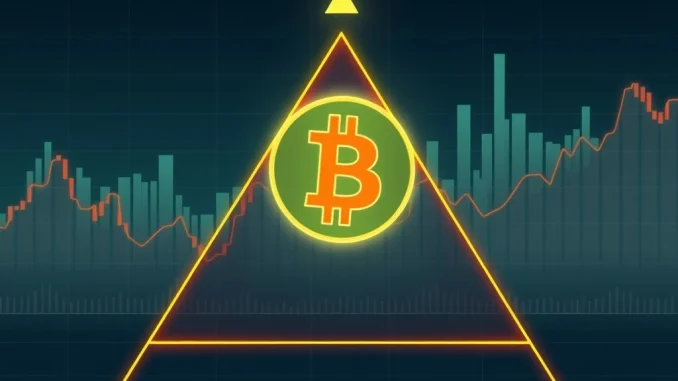
The cryptocurrency market is abuzz with anticipation as Bitcoin, the undisputed king of digital assets, finds itself at a pivotal juncture. Currently, the price action of Bitcoin is locked within a symmetrical triangle pattern, signaling a period of consolidation that often precedes a significant move. This isn’t just a casual observation; it’s a critical moment for anyone interested in crypto, as the resolution of this pattern could dictate the next major trend for the entire ecosystem. With a noticeable drop in trading volume and open interest, the market is holding its breath, awaiting a definitive signal. What does this mean for the immediate future of Bitcoin, and how should traders and investors prepare for the impending volatility?
Bitcoin Price Prediction: What Does the Symmetrical Triangle Mean?
At the heart of the current market narrative is Bitcoin’s consolidation within a symmetrical triangle. This technical formation is characterized by converging trendlines: a descending resistance line and an ascending support line. It typically reflects a period of indecision in the market, where buyers and sellers are in a standoff, leading to tighter and tighter price ranges. For Bitcoin, this pattern is playing out near the $118,520 mark, with immediate boundaries set by $118,000 as crucial support and $119,300 as overhead resistance.
Understanding the indicators:
- Symmetrical Triangle: This pattern suggests that neither buyers nor sellers are in clear control, leading to a ‘squeeze’ in price. Historically, a breakout from such a pattern can occur in either direction, often with significant momentum.
- Relative Strength Index (RSI): Currently hovering at 48.63, the RSI indicates a neutral stance. A reading near 50 suggests that the asset is neither overbought nor oversold, reinforcing the market’s indecision. Traders often look for a move above 70 (overbought) or below 30 (oversold) to signal potential reversals.
- Moving Average Convergence Divergence (MACD): The MACD shows weak positive momentum. While the MACD line is slightly above the signal line, the histogram bars are small, indicating a lack of strong directional conviction. This weak positive momentum could quickly dissipate or strengthen depending on external catalysts.
The combination of these indicators paints a picture of a market poised for a significant move, but one that lacks a clear direction at present. The consolidation is not just a lull; it’s a coiled spring.
Is a BTC Breakout Imminent? Analyzing Key Indicators
While indecision reigns, several technical signals hint at the potential for a decisive BTC breakout. The Ichimoku Cloud analysis, for instance, provides a bullish bias, with Bitcoin’s price remaining above the green cloud region. This suggests that the cloud is acting as a strong support zone, potentially paving the way for an upward trajectory if sustained.
Traders are closely monitoring specific price levels that could act as catalysts for the next move:
| Level | Significance | Potential Action |
|---|---|---|
| $119,300 | Upper resistance of the triangle | Breakout target for bullish momentum |
| $118,800 | Immediate resistance level | Key level for confirming upward momentum |
| $118,520 | Current trading price | Point of consolidation |
| $118,000 | Strong psychological and technical support | Breakdown trigger for bearish move |
| $117,500 | Next support below triangle | Retest zone if $118,000 breaks |
| $117,100 | Further downside support | Deeper pullback potential |
| $115,724 | Critical bearish breakdown level | Confirmation of a potential ‘bull trap’ |
| $120,500 | Higher bullish target | Indicates strong rally continuation |
| $150,000 | Long-term bullish projection | Significant upside if triangle validates upward |
A decisive breach above $118,800 could ignite significant upward momentum, potentially pushing Bitcoin towards $119,800 or even $120,500. Conversely, a breakdown below the $118,000 support would signal a bearish shift, risking a retest of $117,500 and potentially lower levels around $117,100. The tension is palpable as the market awaits which side will gain the upper hand.
Bitcoin Trading Volume and Open Interest: Signals of Caution
Adding another layer of complexity to the current market scenario is the notable decline in Bitcoin trading volume and open interest. Volume, which measures the total number of assets traded over a period, has seen a 15% decline, dropping to $90.8 billion. Open interest, representing the total number of outstanding derivative contracts (like futures and options) that have not been settled, has also decreased by 1.81% to $84.22 billion.
What do these metrics tell us?
- Reduced Trading Volume: A drop in volume during a consolidation phase often signifies a lack of strong conviction from either buyers or sellers. It suggests that fewer participants are actively engaging, leading to reduced liquidity. This can make any eventual breakout more volatile, as less capital is needed to move the price significantly. It also indicates a ‘wait-and-see’ approach among market participants.
- Declining Open Interest: A decrease in open interest, particularly alongside a price consolidation, typically means that leveraged positions are being closed out or that new money isn’t entering the derivatives market. This reflects reduced speculative interest and a cautious sentiment among traders who use futures and options. It can also imply that the market is ‘de-leveraging,’ which can be healthy in the long run but contributes to short-term uncertainty.
The combined effect of reduced Bitcoin trading volume and open interest underscores the prevailing caution in the market. While a breakout is anticipated, the reduced liquidity could lead to sharper moves once the pattern resolves, making risk management even more crucial for traders.
Navigating Crypto Market Volatility: Expert Outlooks
The broader crypto market mirrors Bitcoin’s consolidation, with major altcoins like Ethereum (ETH) and XRP also exhibiting range-bound behavior. However, Bitcoin’s dominance remains paramount; its eventual move will likely set the tone for risk appetite across the entire crypto ecosystem. Analysts are currently split on the trajectory, reflecting the inherent crypto market volatility.
Differing Perspectives:
- Bullish Outlook: Some analysts remain optimistic, anticipating a continuation of the bullish trend that has characterized Bitcoin’s longer-term performance. They project a significant move towards $150,000 if the symmetrical triangle validates an upward breakout. This view often relies on macro factors, increasing institutional adoption, and Bitcoin’s halving cycles.
- Bearish Outlook: Conversely, other experts warn of a potential pullback. They suggest that a breakdown below the $118,000 support, particularly if it dips below $115,724, could trigger a retest of earlier, lower support levels. This perspective often highlights the possibility of a ‘bull trap,’ where price briefly rises before a significant decline, catching over-leveraged long positions off guard.
The 4-hour chart vividly illustrates this tug-of-war near the triangle’s apex. Buyers and sellers are locked in a stalemate, each attempting to push the price in their favor. This dynamic tension is typical of consolidation phases and sets the stage for a potentially explosive move.
Actionable Insights for Bitcoin Technical Analysis
Given the current setup, traders and investors need to approach the market with a well-defined strategy. Here are some actionable insights based on the Bitcoin technical analysis:
- Confirmation is Key: Do not pre-empt the breakout. Wait for a decisive close above $118,800 for a bullish confirmation or a clear break below $118,000 for a bearish signal. False breakouts are common in low-volume environments.
- Monitor Volume Spikes: A genuine breakout, whether up or down, is typically accompanied by a significant surge in trading volume. A breakout on low volume might indicate a lack of conviction and could lead to a quick reversal.
- Set Stop-Loss Orders: Volatility is expected once the pattern resolves. Implementing strict stop-loss orders is crucial to manage risk and protect capital, regardless of the direction of the breakout.
- Watch Macroeconomic Cues: Beyond technicals, global macroeconomic events, such as inflation data, interest rate decisions, and geopolitical developments, can significantly influence market sentiment and potentially act as catalysts for the triangle’s resolution.
- Regulatory Updates: News regarding cryptocurrency regulations in major economies can also sway market sentiment rapidly. Stay informed on any new legislative developments.
The symmetrical triangle acts as both a catalyst for volatility and a barrier to clarity. The market is in a holding pattern, awaiting a definitive catalyst to trigger a decisive move. Patience and diligent monitoring of key levels and broader market signals will be paramount for navigating the coming weeks.
Conclusion
Bitcoin stands at a critical juncture, with its price consolidating within a symmetrical triangle pattern. This period of indecision, characterized by declining trading volume and open interest, signals an impending breakout that could define the next major trend for the leading cryptocurrency. While technical indicators like the Ichimoku Cloud lean bullish, the overall market sentiment remains cautious, with analysts split on whether a rally towards $150,000 or a pullback to $115,724 is more likely. As the market awaits a decisive catalyst—be it a fundamental shift or a strong technical breach—traders must remain vigilant, prioritize risk management, and confirm breakout signals with strong volume. The coming days are set to be pivotal for Bitcoin, influencing the broader crypto landscape and offering both significant opportunities and risks for those who navigate them wisely.
Frequently Asked Questions (FAQs)
Q1: What is a symmetrical triangle pattern in Bitcoin’s price chart?
A symmetrical triangle pattern is a chart formation characterized by two converging trendlines: a descending upper line (resistance) and an ascending lower line (support). It indicates a period of consolidation and indecision in the market, where price movements become increasingly narrow. Traders anticipate a breakout from this pattern, either upward or downward, which often leads to a significant price move.
Q2: Why are declining trading volume and open interest significant for Bitcoin?
Declining trading volume suggests reduced market participation and a lack of strong conviction from buyers or sellers. It means less liquidity, which can make any subsequent price moves more volatile. A drop in open interest indicates that fewer new leveraged positions are being opened, and existing ones might be closing, reflecting a cautious or de-leveraging sentiment among derivative traders. Both signal uncertainty and can precede a sharp move when the market eventually decides on a direction.
Q3: What are the key price levels to watch for a Bitcoin breakout?
For a bullish breakout, traders are watching for a decisive move above immediate resistance at $118,800, with further targets at $119,300, $119,800, and potentially $120,500. On the bearish side, a breakdown below the strong support at $118,000 could lead to a retest of $117,500 and $117,100. A more critical bearish signal would be a break below $115,724.
Q4: How do technical indicators like RSI and MACD inform the current Bitcoin outlook?
The Relative Strength Index (RSI) at 48.63 indicates a neutral momentum, meaning Bitcoin is neither overbought nor oversold, reinforcing the current indecision. The Moving Average Convergence Divergence (MACD) shows weak positive momentum, suggesting that while there’s a slight bullish bias, it’s not strong enough to signal a clear trend. Both indicators support the idea of consolidation and a market awaiting a strong catalyst for direction.
Q5: What broader market factors could influence Bitcoin’s next move?
Beyond technical patterns, macroeconomic cues and regulatory updates are significant influences. Global economic data (like inflation and interest rates), geopolitical events, and news regarding cryptocurrency regulations in major jurisdictions can all act as catalysts. Bitcoin’s price action often reacts strongly to these external factors, tipping the balance once the symmetrical triangle pattern resolves.
Q6: What should traders do during this period of Bitcoin uncertainty?
During periods of uncertainty and consolidation, traders should prioritize patience and risk management. It’s crucial to wait for confirmed breakouts (supported by strong volume) before making significant moves. Setting strict stop-loss orders is vital to protect capital. Additionally, staying informed about macroeconomic developments and regulatory news can provide crucial context and help anticipate potential catalysts for a decisive move.



